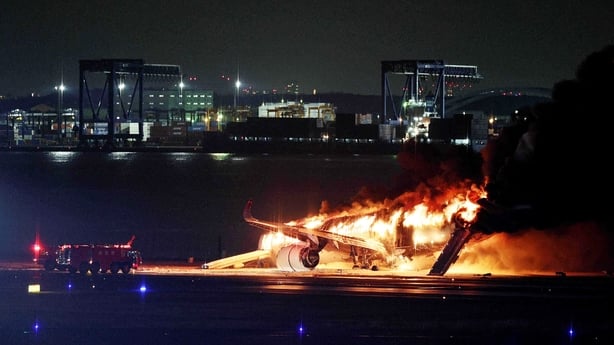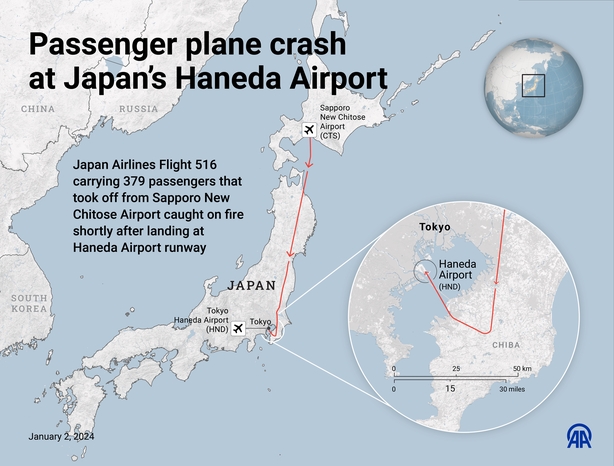All 379 passengers and crew of a Japan Airlines plane miraculously escaped from a fire following a collision with a coastguard aircraft at Tokyo's Haneda Airport, but five of the six crew of the coastguard plane were killed.
The coastguard said the collision involved one of its planes that was headed to Niigata Airport on Japan's west coast to deliver aid to those caught up in a powerful earthquake that struck on New Year's Day, killing at least 48 people.
"I felt a boom like we had hit something and jerked upward the moment we landed," a passenger on the Japan Airlines flight told Kyodo news agency.
"I saw sparks outside the window and the cabin filled with gas and smoke."
Live footage on public broadcaster NHK showed the Japan Airlines (JAL) Airbus A350 aircraft bursting into flames as it skidded down the tarmac shortly before 6pm (9am Irish time).
It was later overwhelmed by the blaze despite efforts by rescue crews to control the fire. But not before all 367 passengers and 12 crew were evacuated.
Japan's Transport Minister Tetsuo Saito confirmed that five of the coast guard aircraft's crew had died. The captain of the plane escaped but was injured.
NHK, citing the Tokyo Fire Department, said at least 17 of the people evacuated from the passenger plane were injured.

A transport ministry official told a press briefing the JAL plane was attempting to land normally when it collided with the coastguard's Bombardier-built Dash-8 maritime patrol plane on the runway.
There had been no reports of engine or other problems on the aircraft before it landed, the official said.
Footage and images shared on social media showed passengers shouting inside the smoke-filled cabin and running across the tarmac away from an evacuation slide.
Video also showed passengers being evacuated calmly via escape slides, apparently without hand luggage.
"The cabin crew must have done an excellent job. There don't seem to be any carry-ons. It was a miracle that all the passengers got off," said Paul Hayes, director of air safety at UK-based aviation consultancy Ascend by Cirium.
Aviation safety agencies have warned for years that pausing to collect carry-on baggage during an evacuation risks lives.

Kaoru Ishii, a mother who was waiting outside the arrival gate for her 29-year-old daughter and boyfriend coming back on the flight said she initially though the flight was delayed until her daughter called to explain.
"She said the plane had caught fire and she exited via a slide," Ms Ishii said. "I was really relieved that she was alright."
A spokesperson at Japan Airlines said its aircraft had departed from New Chitose airport on the northern island of Hokkaido.
Haneda, one of the two main airports serving the Japanese capital, was closed for several hours following the accident, but the transport ministry official said three runways had since resumed operations.
JAL's rival Japanese airline ANA had earlier said it had cancelled 110 domestic flights departing and landing at Haneda for the rest of today due to the runway shutdown.
Mr Saito said the cause of the accident was unclear and the Japan Transport Safety Board (JTSB), police and other departments would continue to investigate.
We need your consent to load this rte-player contentWe use rte-player to manage extra content that can set cookies on your device and collect data about your activity. Please review their details and accept them to load the content.Manage Preferences
Prime Minister Fumio Kishida said authorities were working to ensure the accident at Haneda did not affect deliveries of earthquake relief supplies.
"This is a great regret as the crew members performed their duties with a strong sense of mission and responsibility for the victims of the disaster area," he said, referring to those killed on the coastguard plane.
Japan has not suffered a serious commercial aviation accident in decades.
Its worst ever was in 1985, when a JAL jumbo jet flying from Tokyo to Osaka crashed in central Gunma region, killing 520 passengers and crew.
That disaster was one of the world's deadliest plane crashes involving a single flight.
